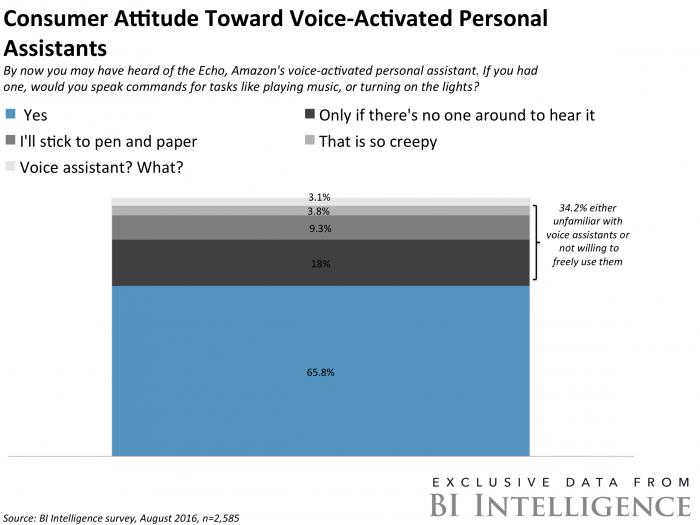IBM rolls out advertising campaign powered by artificial intelligence (IBM)
This story was delivered to BI Intelligence "Digital Media Briefing" subscribers. To learn more and subscribe, please click here.

BI Intelligence
IBM-owned The Weather Company is rolling out a voice- and display-advertising campaign that will be powered by its artificial intelligence (AI) supercomputer Watson, Adweek reports. IBM has developed a Watson API for the Campbell's Soup to create personalized ads based on a user’s location, the weather in their area, and the ingredients they want to cook with. This ad format is in an embryonic stage, but it could be the beginning of a new frontier in voice- and AI-based marketing for the following reasons:
These campaigns resemble voice-search advertising. Users can interact with these Campbell's ads by speaking into the microphone, and asking Watson for dish suggestions based on a list of ingredients and a list of the top 10 recipes others have searched for. These kinds of ads will likely become more common as voice becomes a more common interface for human-to-computer interaction. It might eventually make its way to popular voice-platforms like Amazon’s Alexa, Apple’s Siri and Google’s Allo Assistant.
Creating personalized ads with algorithms and data. The utopian goal of the advertising industry is creating truly one-to-one ads based on individual data. This is unlikely to be perfectly achieved, but a semblance could be realized if marketers can make use of deep learning techniques in text- and image-recognition, and natural language processing, in their creative campaigns. In this ideal scenario, an ad would be able to process what a user is looking for, and formulate a result that satisfies this want.
Watson ads are being used for other industry sectors. Later this year, IBM Watson will power a campaign for pharmaceutical company GlaxoSmithKline to promote Theraflu later this year. For these ads, users will be able to ask Watson questions about various flu symptoms. And in Q1 2017, IBM will run a campaign for Toyota, creating cognitive ads for the auto sector. How these ads perform will provide a clearer picture of whether voice advertising can be applied for different industries.
Advancements in artificial intelligence, coupled with the proliferation of messaging apps, are fueling the development of chatbots — software programs that use messaging as the interface through which to carry out any number of tasks, from scheduling a meeting, to reporting weather, to helping users buy a pair of shoes.
Foreseeing immense potential, businesses are starting to invest heavily in the burgeoning bot economy. A number of brands and publishers have already deployed bots on messaging and collaboration channels, including HP, 1-800-Flowers, and CNN. While the bot revolution is still in the early phase, many believe 2016 will be the year these conversational interactions take off.
Laurie Beaver, research associate for BI Intelligence, Business Insider's premium research service, has compiled a detailed report on chatbots that explores the growing and disruptive bot landscape by investigating what bots are, how businesses are leveraging them, and where they will have the biggest impact.
The report outlines the burgeoning bot ecosystem by segment, looks at companies that offer bot-enabling technology, distribution channels, and some of the key third-party bots already on offer. The report also forecasts the potential annual savings that businesses could realize if chatbots replace some of their customer service and sales reps. Finally, it compares the potential of chatbot monetization on a platform like Facebook Messenger against the iOS App Store and Google Play store.
Here are some of the key takeaways:
AI has reached a stage in which chatbots can have increasingly engaging and human conversations, allowing businesses to leverage the inexpensive and wide-reaching technology to engage with more consumers.
Chatbots are particularly well suited for mobile — perhaps more so than apps. Messaging is at the heart of the mobile experience, as the rapid adoption of chat apps demonstrates.
The chatbot ecosystem is already robust, encompassing many different third-party chat bots, native bots, distribution channels, and enabling technology companies.
Chatbots could be lucrative for messaging apps and the developers who build bots for these platforms, similar to how app stores have developed into moneymaking ecosystems.
In full, the report:
Breaks down the pros and cons of chatbots.
Explains the different ways businesses can access, utilize, and distribute content via chatbots.
Forecasts the potential impact chatbots could have for businesses.
Looks at the potential barriers that could limit the growth, adoption, and use of chatbots.
To get your copy of this invaluable guide, choose one of these options:
Subscribe to an ALL-ACCESS Membership with BI Intelligence and gain immediate access to this report AND over 100 other expertly researched deep-dive reports, subscriptions to all of our daily newsletters, and much more. >> START A MEMBERSHIP
Purchase the report and download it immediately from our research store. >> BUY THE REPORT
The choice is yours. But however you decide to acquire this report, you’ve given yourself a powerful advantage in your understanding of chatbots.
See Also:

 Yahoo News
Yahoo News 
